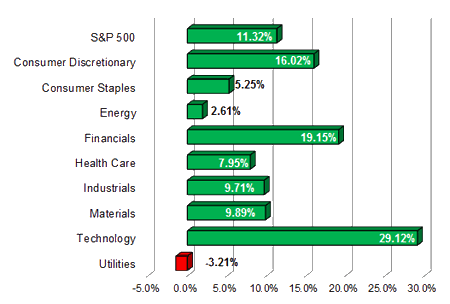
Market Commentary by Scott J. Brown, Ph.D., Chief Economist

As expected, the Federal Open Market Committee left short-term interest rates unchanged and refrained from additional asset purchases. The Fed still expects that “economic conditions – including low rates of resource utilization and a subdued outlook for inflation over the medium run – are likely to warrant exceptionally low levels for the federal funds rate at least through late 2014.”However, officials were still divided on when they thought it would be appropriate to start tightening. Officials revised higher their projections for 2012 GDP growth, but slightly lower their growth expectations for 2013 and 2014.
Real GDP rose at a 2.2% annual rate in the advance estimate for 1Q12, below the +2.5% median forecast. The details were a mixed bag. Consumer spending rose at a 2.9% annual rate, led by a sharp increase in motor vehicles. Business fixed investment fell at a 2.1% pace (structures down 12.0%, equipment and software up 1.7%).
Residential fixed investment picked up, adding 0.4 percentage point to GDP growth. A faster pace of inventory accumulation (likely unintentional) added 0.6 percentage point. Government remained a drag on overall growth, subtracting 0.6 percentage point. An increase in exports was roughly offset by an increase in imports. The PCE Price Index ex-food and energy rose 2.1% (+1.9% y/y), very near the Fed’s inflation target.
Stock market participant began the week worrying about global growth, but the market spit out bad news at the end of the week (a disappointing GDP report, developments in Spain).
Next week, the focus is expected to be on the April Employment Report. The unusually mild winter likely shifted seasonal job gains from March and April into January and February, but it’s unclear how much of a payback we’ll see in April. In addition, higher gasoline prices may have dampened the pace of hiring.
Indices
| Last | Last Week | YTD return % | |
| DJIA | 13204.62 | 12964.10 | 8.08% |
| NASDAQ | 3050.61 | 3007.56 | 17.10% |
| S&P 500 | 1399.98 | 1376.92 | 11.32% |
| MSCI EAFE | 1513.11 | 1502.34 | 7.12% |
| Russell 2000 | 818.33 | 798.90 | 10.45% |
Consumer Money Rates
| Last | 1-year ago | |
| Prime Rate | 3.25 | 3.25 |
| Fed Funds | 0.10 | 0.14 |
| 30-year mortgage | 3.97 | 4.85 |
Currencies
| Last | 1-year ago | |
| Dollars per British Pound | 1.619 | 1.648 |
| Dollars per Euro | 1.324 | 1.463 |
| Japanese Yen per Dollar | 80.850 | 81.760 |
| Canadian Dollars per Dollar | 0.984 | 0.951 |
| Mexican Peso per Dollar | 13.203 | 11.569 |
Commodities
| Last | 1-year ago | |
| Crude Oil | 104.55 | 112.21 |
| Gold | 1658.06 | 1502.23 |
Bond Rates
| Last | 1-month ago | |
| 2-year treasury | 0.33 | 0.29 |
| 10-year treasury | 2.15 | 2.01 |
| 10-year municipal (TEY) | 2.89 | 3.29 |
Treasury Yield Curve – 4/27/2012
S&P Sector Performance (YTD) – 4/27/2012
Economic Calendar
| April 30th |
— |
Personal Income and Spending (March) Chicago Purchasing Managers Index (April) |
| May 1st |
— |
Construction Spending (March) ISM Manufacturing Index (April) Motor Vehicle Sales (April) |
| May 2nd |
— |
ADP Payroll Estimate (April) |
| May 3rd |
— |
Jobless Claims (week ending April 28th) Productivity (1Q12, preliminary) ISM Non-Manufacturing Index (April) |
| May 4th |
— |
Employment Report (April) |
| May 10th |
— |
Trade Balance (March) |
| May 11th |
— |
Producer Price Index (April) |
| May 15th |
— |
Consumer Price Index (April) Retail Sales (April) |
| June 20th |
— |
FOMC Policy Decision Bernanke Press Briefing |
Important Disclosures
US government bonds and treasury bills are guaranteed by the US government and, if held to maturity, offer a fixed rate of return and guaranteed principal value. US government bonds are issued and guaranteed as to the timely payment of principal and interest by the federal government. Treasury bills are certificates reflecting short-term (less than one year) obligations of the US government.
Commodities trading is generally considered speculative because of the significant potential for investment loss. Markets for commodities are likely to be volatile and there may be sharp price fluctuations even during periods when prices overall are rising. Specific sector investing can be subject to different and greater risks than more diversified investments.
Tax Equiv Muni yields (TEY) assume a 35% tax rate on triple-A rated, tax-exempt insured revenue bonds.
![]() Material prepared by Raymond James for use by its financial advisors.
Material prepared by Raymond James for use by its financial advisors.
The information contained herein has been obtained from sources considered reliable, but we do not guarantee that the foregoing material is accurate or complete. Data source: Bloomberg, as of close of business April 26th, 2012.
©2012 Raymond James Financial Services, Inc. member FINRA / SIPC.




